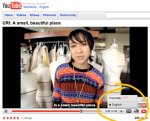Here’s a chance for a little interactivity for all the bloggers out there. Below is a list of 100 things that I think every good omnivore should have tried at least once in their life. The list includes fine food, strange food, everyday food and even some pretty bad food – but a good omnivore should really try it all. Don’t worry if you haven’t, mind you; neither have I, though I’ll be sure to work on it. Don’t worry if you don’t recognise everything in the hundred, either; Wikipedia has the answers.
Here’s what I want you to do:
1) Copy this list into your blog or journal, including these instructions.
2) Bold all the items you’ve eaten.
3) Cross out any items that you would never consider eating.
4) Optional extra: Post a comment here and/or at www.verygoodtaste.co.uk linking to your results.
- Venison
- Nettle tea
- Huevos rancheros
- Steak tartare
- Crocodile
- Black pudding
- Cheese fondue
- Carp
- Borscht
- Baba ghanoush
- Calamari
- Pho
- PB&J sandwich
- Aloo gobi
- Hot dog from a street cart
- Epoisses
- Black truffle
- Fruit wine made from something other than grapes
- Steamed pork buns
- Pistachio ice cream
- Heirloom tomatoes
- Fresh wild berries
- Foie gras
- Rice and beans
- Brawn, or head cheese
- Raw Scotch Bonnet pepper
- Dulce de leche
- Oysters
- Baklava
- Bagna cauda
- Wasabi peas
- Clam chowder in a sourdough bowl
- Salted lassi
- Sauerkraut
- Root beer float
- Cognac with a fat cigar
- Clotted cream tea
- Vodka jelly/Jell-O
- Gumbo
- Oxtail
- Curried goat
- Whole insects
- Phaal
- Goat’s milk
- Malt whisky from a bottle worth £60/$120 or more
- Fugu
- Chicken tikka masala
- Eel
- Krispy Kreme original glazed doughnut
- Sea urchin
- Prickly pear
- Umeboshi
- Abalone
- Paneer
- McDonald’s Big Mac Meal
- Spaetzle
- Dirty gin martini
- Beer above 8% ABV
- Poutine
- Carob chips
- S’mores
- Sweetbreads
- Kaolin
- Currywurst
- Durian
- Frogs’ legs
- Beignets, churros, elephant ears or funnel cake
- Haggis
- Fried plantain
- Chitterlings, or andouillette
- Gazpacho
- Caviar and blini
- Louche absinthe
- Gjetost, or brunost
- Roadkill
- Baijiu
- Hostess Fruit Pie
- Snail
- Lapsang souchong
- Bellini
- Tom yum
- Eggs Benedict
- Pocky
- Tasting menu at a three-Michelin-star restaurant.
- Kobe beef
- Hare
- Goulash
- Flowers
- Horse
- Criollo chocolate
- Spam
- Soft shell crab
- Rose harissa
- Catfish
- Mole poblano
- Bagel and lox
- Lobster Thermidor
- Polenta
- Jamaican Blue Mountain coffee
- Snake



